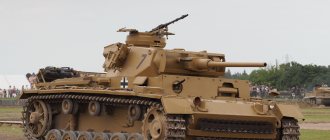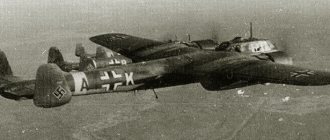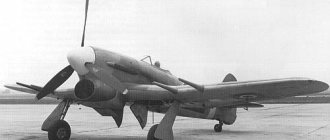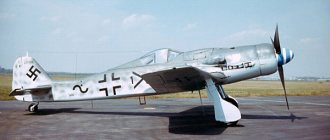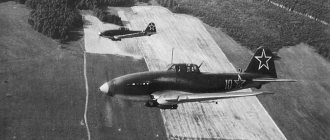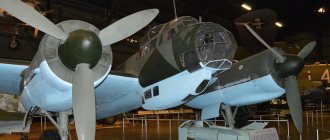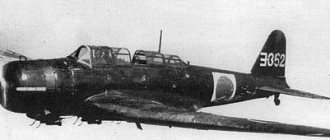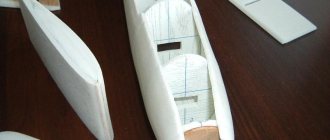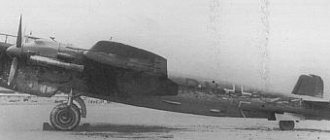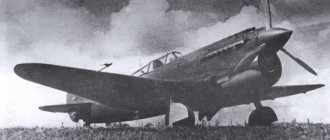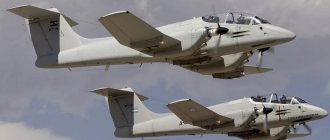Probably anyone will agree that during the Great Patriotic War, Soviet aviation played a huge role in the victory over an extremely dangerous, skillful and cruel enemy. But if some aircraft, for example, Il-2 or Yak-3, are constantly in the news, and almost everyone who is even slightly interested in history knows about them, then others do not enjoy such fame, if only because they were produced significantly less. The latter also includes the Pe-8 heavy bomber. But for its time it was an advanced aircraft. And he made a huge contribution to the victory. Therefore, it deserves attention.
A little about the plane
This aircraft was designed as a high-speed, high-altitude heavy bomber capable of flying a significant distance to a target - before this, the Soviet Union simply did not have truly reliable analogues.
However, thanks to the principles used in its creation, the aircraft could be used not only for bombing, but also for various military transport purposes, including the transportation of personnel and cargo over long distances. In all respects, it could be classified into a conditional category called the “flying fortress.”
Compared with previous Soviet experience in creating heavy aircraft, the Pe-8 no longer resembled angular machines with corrugated skin. Instead, it received a streamlined shape, which further improved the aircraft's performance. The designers managed to combine the best features of the TB-3, DB-A and SB - three aircraft, each of which had certain advantages, but still did not meet the requirements of the selection committee.
Together with Tupolev
It has been said: there is no prophet in his own Fatherland. The future eminent aircraft designer Vladimir Mikhailovich Petlyakov was also not immediately recognized - he entered the mechanical faculty of MTU (now MSTU named after N.E. Bauman) only on his second attempt. But since the family needed funds, and he was the eldest of the brothers, he had to postpone his studies and earn his daily bread on the railway.
He was restored to MTU only in 1917, studied and at the same time worked as a technician in the aerodynamic laboratory under the leadership of HE Zhukovsky. In 1921, he moved to the position of laboratory assistant to Andrei Nikolaevich Tupolev at TsAGI. The next year he defended his defense and became a certified mechanical engineer.
Working under Tupolev, the young designer developed a monoplane with “metallic elements,” which he named “ANT” in honor of his leader. The next monoplane from the same series was already all-metal. Being responsible for the design of the wings, V.M. Petlyakov and V.N. Belyaev developed a method for calculating the strength of metal multi-spar wings, which was used by all design bureaus in the country for a long time. Then the ANT-3 (R-3) aerial reconnaissance aircraft appeared - an aircraft that made record flights. The first-born of the series, named “Proletarian,” flew 7,150 km, and the next aircraft, called “Our Answer,” already covered 22,000 km.
The history of the creation of the ANT-4 (TB-1), which became the country's first heavy bomber, is noteworthy. The order for the creation of a heavy aircraft capable of dropping mines, bombs and torpedoes was supposed to be placed in England at the famous one, but they asked for too much money and set a rather long period for completing the work - a year and a half. This did not suit the country.
Then TsAGI carried out preliminary calculations, and as a result, in just nine months, a bomber was created, which became a triumph in the domestic aircraft industry. Such an aircraft, called the “Country of Soviets,” was not ashamed to show abroad.
© Photo from the ANT-4 archive, called “Country of Soviets,” was not ashamed to show abroad.
The plane made an ultra-long flight along the route Moscow - Petropavlovsk-Kamchatsky - San Francisco - New York. And in 1933 A.V. Lyapidevsky on ANT-4 saved the Chelyuskinites. After the creation of the ANT-4, Andrei Tupolev appointed Petlyakov responsible for flight testing of all subsequent design bureau vehicles and their transfer into production. Looking ahead, we note that during the Soviet-Finnish War of 1939-1940. TB-1 played a decisive role in breaking through the Mannerheim Line.
An interesting detail. Taking part in the development of the ANT-6 (TB-3), Petlyakov invented a gas tank design that was used by many designers for more than twenty years. But what about the gas tank... The wingspan of the plane was almost 42 meters. With three tons of bombs, he could rise to a height of up to 8,000 meters. TB-3 became the country's main bomber. For the creation of that machine V.M. Petlyakov was awarded the Orders of the Red Star and Lenin.
The bomber took part in the battles at Khalkhin Gol, in the Soviet-Finnish War, and was used in the first period of the Great Patriotic War. Has gone through several upgrades for different tasks. Until June 22, 1941, 516 vehicles were delivered to aviation and 25 to the Navy. However, due to its low speed, the TB-3 began to be used as night bombers.
© Photo from the archive
Petlyakov participated in the development of the largest aircraft of that time - the “air propaganda station” ANT-20 “Maxim Gorky”.
Vladimir Mikhailovich also participated in the development of the largest aircraft of that time - the “air propaganda station” ANT-20 “Maxim Gorky”, the length of which was 33 meters with a wingspan of 63 meters. Eight engines with a total power of 7,500 hp. lifted up to 53 tons. Unfortunately, on May 18, 1935, the plane crashed. 11 crew members and 47 passengers were killed.
Then participation in the creation of the ANT-25 “RD” (“RD” is a range record). It was on this machine that two record flights to the United States were made across the North Pole. V.M. Petlyakov was responsible for technical preparation.
History of creation
The importance of creating a truly powerful and practically invulnerable long-range heavy bomber was understood in the USSR even earlier than in the USA - in 1930, while the overseas allies began work on its creation only in 1934.
The Central Aerohydrodynamic Institute received a number of requirements that the new bomber had to meet. First of all, it has a significant flight range - at least 4,500 kilometers. Moreover, it was supposed to reach speeds of up to 440 kilometers per hour, have a ceiling of about 11 kilometers and a bomb load of 4 tons or more.
Work began immediately, and the first result was TB-3. However, it did not meet the requirements - although the bomb load even exceeded the required one (about 10 tons), the speed and ceiling were 250 kilometers per hour and 7 kilometers, respectively.
Three years later, TB-7 was created. But he also did not satisfy the requirements of the selection committee.
As a result, the Soviet long-range bomber Pe-8 was created and maximally improved only in 1939. Immediately after this it was put into production. True, it was originally called TB-7. It received a new and familiar name only in 1942.
The Red Army Air Force received the aircraft in the spring of 1941. But it was discontinued in 1944 - many more promising developments appeared. However, during this time, 97 aircraft were created, including two experimental prototypes.
Pe-8: Stalin’s “Flying Fortress” (37 photos)
At the end of the 30s, the largest Soviet aircraft, the Pe-8 heavy bomber, was created and put into mass production. There is no doubt that the TsAGI design team, headed by Tupolev, managed to create an advanced bomber, which in most technical characteristics was not inferior to similar foreign machines.
The very good flight characteristics and convincing combat capabilities of this machine made it possible not only to increase the air power of the state, but also to confidently count on carrying out large-scale strategic operations. At the same time, during the period of its creation, the Pe-8 was not a super complex object or a miracle of technology. It was built using technology quite accessible to the Soviet aviation industry.
The Pe-8 did not completely fit into the large-scale plans for pre-war construction. It was discontinued several times, which did not allow the construction of even a hundred of these machines. But, nevertheless, Pe-8 formations left a noticeable mark on history. They bombed Berlin and Königsberg. And during the formation of Long-Range Aviation they turned out to be the most powerful machines. It was the Pe-8 that flew across warring Europe and the Atlantic to the United States, and it was the Pe-8 that lifted the 5-ton bomb. Thanks to the presence of the Pe-8, it was possible to form formations that later formed the basis of the strategic aviation of the USSR.
By the mid-30s. of the last century, the Soviet heavy bomber TB-3 was outdated. A new aircraft of this class was urgently needed: the speed was 2-2.5 times higher than the TB-2, with a ceiling of 10,000 m, and powerful defensive weapons. The Air Force Directorate formulated the requirements for the new vehicle in the task for the development of a bomber with the index TB-7. On June 26, 1934, this document was received by TsAGI. On July 27, Tupolev asked NTS TsAGI to transfer the task to team No. 1 KOSOS (Design Department of the Experimental Construction Sector), headed by Petlyakov.
I must say that the task looked difficult. The Red Army Air Force wanted to get an aircraft whose characteristics significantly exceeded the capabilities of not only domestic but also global industry. Back in the spring of 1930, TsAGI was tasked with creating a bomber with a maximum speed of 440 km/h, a range of 4,500 km, a ceiling of 11,000 m, and a bomb load of 4,000 kg.
Many of the requirements for TB-7 clearly came from this document. But now the requirements have increased: a maximum speed of 600 km/h, a ceiling of 15,000 m, a flight range of more than 2,000 km at this altitude. Later, TsAGI management managed to convince the military to put forward more realistic demands, based on the calculations of the Kosos employees.
In fact, work on the ANT-42 project began in Petlyakov’s brigade on July 29, 1934. The preliminary layout of the aircraft was carried out by Tupolev, Kondorsky and Petlyakov. The latter was actually the chief designer of the machine. The lead designer was his deputy Nezval.
In the spirit of the times, an all-metal monoplane with a smooth load-bearing skin, fully retractable landing gear, and closed cabins was created. The center section was developed by Popov, the Saukke wing, the fuselage and tail by Myasishchev, the Sokolov control system, Kotenko's motor installations, Agladze's chassis, Kerber's special equipment, Meyerson's armament, Belyaev's strength, Mateveyev's aerodynamics.
The invulnerability of the machine was to be ensured by altitude and speed. The first made it possible to avoid anti-aircraft artillery fire, the second to avoid interception by fighters. This meant that the bomber had to have an operating altitude of at least 10,000 m and reach a speed of at least 440 km/h. The flight range with 2000 kg bombs is at least 4500 km.
On December 23, 1934, a calculation and design note for a version of the vehicle with four M-34FRN engines without a central pressurization unit was placed on Tupolev’s desk. At the same time, the UVVS adjusted the requirements for TB-7 towards a more realistic approach. The new task was approved by the head of the Red Army Air Force Alksnis on January 31.
At the beginning of April 1935, TsAGI sent its comments on the requirements to the UVVS. On December 2, 1935, the first inspection of a full-size mock-up by Air Force representatives took place. On December 14, TsAGI sent a preliminary design of the future TB-7 to the UVVS. As of January 1, 1936, the project completion rate was 57%. On April 22, 1936, the ANT-42 model was presented to a commission headed by Deputy People's Commissar of Defense Tukhachevsky.
The first ANT-42 was ready by November 9th.
The plane first took off on December 27, 1936 from the Central Aerodrome under the control of TsAGI chief pilot Gromov.
After landing, Gromov reported that the car was quite stable and easy to control. After subsequent modifications, three more flights were made from the Central Airfield. Until March 20, 1937, Gromov completed 14 more full-fledged test flights, which made it possible to identify many of the shortcomings of the machine. It was recognized that the speed of 370 km/h was not sufficient; it was necessary to increase the efficiency of the steering wheel, modify the propeller-motor group, and instrumentation. After a forced relocation to the Podlipki airfield, on the very first test flight the ANT-42, under the control of pilot Ryabushkin, suffered an accident during landing. As a result, the navigator's cabin was crushed, the chassis was broken, and the engine mounts were deformed.
(pictured Gromov)
Restoration of the vehicle ended on August 1, 1937, after which it was prepared for a control flight, but an instruction was received from the Air Force to urgently transfer the vehicle for state testing. A team from the Air Force Research Institute headed by Markov and pilot Stefanovsky arrived at the factory airfield.
The car was transported to the Air Force Research Institute. This flight was counted as a check flight after repairs.
This is what Stefanovsky left in his memoirs: “It was 1937. A big war was approaching. Therefore, the head of the Air Force Alksnis took the organization of combined tests of the TB-7 into his own hands, appointing Markov as the leading test engineer,..., me as the commander of the ship, and Bryandinsky as the navigator... ...Autumn was approaching. Therefore, the testing period was extremely short... Four uprated AM-34FRNB engines maintain a power of 4800 hp. up to an altitude of 3500-4000 m. The fifth M-100 engine (named ACN-2) is installed in the fuselage fairing behind the pilot’s back. It increases the main altitude to 8000 m and is launched in flight as needed. Thanks to this, the multi-ton airship, with its maximum flight performance at a ten-kilometer altitude, surpassed all the best European fighters of that time ... "
(Stefanovsky)
State tests of the ANT-42 were carried out from August 11 to October 28, 1937. With a flight weight of 23,860 kg, the maximum speed was 403 km/h at an altitude of 8,000 m. The range with a take-off weight of 28,000 kg was determined to be 3,000 km. Based on the tests, the following conclusion was made:
“The aircraft is modern in its technical specifications. Its available speed of 403 km/h at H=8000 m makes it low-vulnerable at this altitude and above by modern fighters.” The disadvantages included the lack of development of the VMG, the lack of serial AM-34FRNV, the weight of the aircraft was considered too high, the firepower of defensive installations was considered weak and did not meet the requirements.”
In early March 1938, the car flew to Evpatoria. By that time, Nezval was appointed chief designer. Here, in a three-hour control flight, Stefanovsky at an altitude of 8600 m with the ACN-2 turned on reached a speed of 440 km/h.
Stefanovsky recalled about this period of work:
“In general, we were extremely lucky during these tests. When the weather in Moscow turned bad, we continued them in Crimea, under the sun. ... We reached a ceiling unheard of at that time for a heavy airship with incomplete flight weight - 12,000 m! We completed a test program for combat bombing. They loaded large-caliber bombs into the fuselage, gained 10,000-11,000 m, and at each approach dropped one on a small oblong island located northwest of Yevpatoria. During the bombing, all crew members, except, of course, the pilots and flight engineer, lay down on the floor and watched through the viewing window as Sasha Bryandinsky, with each new approach, like a draftsman, gnawed the island into two halves with mathematical precision.”
The results obtained were immediately reported to the head of the Air Force Research Institute Filin, who arrived in Yevpatoria the next day. Here he personally performed one check flight to ensure success.
Returning to Moscow, Filin reported the results obtained to the command of the Red Army Air Force. The test report stated the following:
“a) the aircraft has a ceiling greater than that of modern high-speed fighters; b) aircraft speeds at altitudes of 7000-8000 m are equal to the speeds of modern high-speed fighters; c) has a good takeoff with a flight weight of 30,000 kg, takeoff length of 700 m; d) provides a flight range without the use of supercharging with 2000 kg of bombs - 3000 km; e) direct communication between the main crew and heating of the cabins ensures a long stay at altitudes of 8000-10000 m; f) high maneuverability of the aircraft at altitudes of 8000-10000 m, provides targeted bombing from these altitudes and good maneuver protection from air defense fire. All these qualities make the aircraft practically invulnerable to modern means of attack. The Air Force Research Institute insists on the immediate introduction of the TB-7 aircraft into mass serial production in 1938 and its adoption into service with the Red Army Air Force.”
(Owl)
Although the conclusion of the Air Force Research Institute looked pretentious, it was obvious that the new machine was good.
On April 20, 1938, the head of the GUAP Kaganovich informed Nezval that his vehicle, designated TB-7, had been adopted by the Red Army Air Force and would be mass-produced in Kazan.
Further tests were carried out on the second “backup” prototype. On May 1, 1939, the first ANT-42 flew over Red Square.
The second ANT-42 “backup” was chosen as a model for serial construction. It had significant improvements in technology and maintenance. The test flight of the second aircraft took place on June 26, 1938, and joint tests began on August 11, which confirmed the high performance characteristics of the aircraft.
Since the beginning of the war, the ANT-42 “D” was in Kazan and did not fly. Here the commander of the bomber formation, Vodopyanov, drew the attention of him. After repairs at the end of 1942, it was included in the 890th BAP.
The famous navigator Akkuratov achieved a transfer to the active army at the beginning of 1943. He began to fly the ANT-42 “D”, which was used as an illumination aircraft, i.e. he was flying ahead of the main formation of bombers:
“It was not easy for us to detect targets, especially at night. It was no coincidence that the most experienced navigators were included in the crew of the illuminating aircraft, who always accurately reached the target and hung “chandeliers” of dozens of hundred-kilogram bombs over it. Bombers with high-explosive and thermite bombs came out into their light. What the enemy did not do, trying to hide his objects from us! If before the Battle of Kursk, hearing the roar of the engines of our cars from afar, he opened heavy fire and turned on dozens of searchlights (and this helped us reach the target!), but now the Nazis hid until control bombs fell on the target. It was then that the Nazis’ nerves could not stand it, and they opened indiscriminate fire. And the illuminator, making sure that the target had been found, walked over it, dodging searchlights and anti-aircraft shells and methodically, at a strictly appointed time, hung up to forty luminous bombs - this was quite enough to ensure the operation of all bombers. And after the operation, the lighting crew had to check the results of the bombing and photograph the object processed by the pilots. If the other aircraft were in the fire zone for one and a half to two minutes, then the illuminator hung over the target for up to 45 minutes. I would be lying if I claimed that the crews greeted the navigator-lighter with enthusiasm. To be honest, one such flight was equivalent to 10-15 “regular” combat flights. But such tasks were considered honorable in our country, and the pilots were proud of them as recognition of their high training and valor. Experienced, bombarded pilots got used to anti-aircraft fire and confidently maneuvered among shell explosions. But when the enemy suddenly stopped firing, and the searchlights began to hunt our vehicles especially furiously, it became alarming - it was clear that enemy fighters were entering the battle. Moving away from them, the pilots threw heavy vehicles into dives, during which wild pain dug into their eardrums, or into crazy combat turns, when it seemed that a wing or tail was about to come off. Incredibly, the thirty-ton bomber, vibrating and trembling from sharp evolutions and the firing of its cannons and machine guns, withstood all these loads and slipped away into the saving darkness. From the side, the battle with enemy fighters creeping up on us from our tail presented a terrible but exciting picture. The fire of rapid-fire cannons and heavy machine guns forced the fascist pilots to retreat or cut off the predator. And on the short summer nights, returning home, we usually climbed to a considerable height and, turning on the autopilot, watched the attempts of the Luftwaffe pilots to overtake us. As a rule, at an altitude of 8000-8500 m they went into a tailspin - the rarefied atmosphere affected them. In those days, we had no idea about high-altitude spacesuits, without which flying at high altitudes is unthinkable these days. Insulated overalls and the same oxygen masks helped us out, but any movement took our breath away, our vision immediately grew dark, and apathy set in. However, it was no easier for the fascist pilots, and sometimes, when we noticed their aircraft, we argued at what altitude this or that one would “fall down”. By the way, we also went to the heights because the small-caliber artillery fire that accompanied us to the front line was ineffective there, and we avoided the large-caliber ones. ...In this case we put on oxygen masks. The temperature in the cabin is the same as outside, i.e. -20 degrees C, or even -40 degrees. S. When we climbed to 7000 m, the thermometer showed -55 degrees. WITH. …"
The ANT-42 “D” dropped about 500 tons of bombs, a million leaflets, and delivered several reconnaissance groups to the rear. “The Understudy,” nicknamed “Beard,” celebrated Victory Day in combat formation.
(Exactly)
The military demanded that production of an installation series of five TB-7s begin on January 1, 1938. But this was completely impossible.
The preparation of serial drawings began in April 1937, however, based on the test results, many changes were made to them over and over again. The drawings were submitted to plant No. 124 only at the end of 1938. At the beginning of 1939, the assembly of the first production aircraft began.
Things were going hard. The plant lacked trained specialists; components arrived in the wrong quantities and at the wrong time. The supply of main engines AMP-34FRN has become more complicated. However, on May 1, 1939, a plane piloted by Air Force Research Institute pilots Kabanov and Nyukhtikov flew over Red Square.
The first six vehicles (with 4 AM-34FRNT engines with ACN-2 and 2 with AM-35 without ACN) at the end of 1940 were transferred to the 14th TBAP, based at the Boryspil airfield near Kiev. By the end of the year, it was possible to fully equip 4 more vehicles, and two more at the beginning of 1941.
On May 27, 1940, a decree of the People's Commissariat of Defense was issued, which specified the requirements for TB-7. At the same time, four engine installation options were considered: new AM-35 engines and three types of diesel engines: M-30, M-40 and M-40F. There was no longer any talk about the central pressurization unit. Why did you decide to switch to diesels? After all, diesel is heavier than gasoline with equal power. However, for a long-range aircraft, the total weight of the engine unit and fuel was less. In addition, the diesel engine ran on tractor kerosene, which is easier to obtain than high-octane gasoline.
In Germany, Junkers diesel engines were installed on some aircraft models. In 1933, in the USSR, Charomsky created the first aviation diesel engine, the AN-1. In 1938, the AN-1RTK appeared with a take-off power of 1200 hp, and the specific fuel consumption was one and a half times less than that of a gasoline one. On January 16, 1941, the first vehicle with the M-40 entered state testing at the Air Force Research Institute. As noted in the act, the aircraft had data that met the requirements of the resolution of the Defense Committee, but the VMG was not fully developed and in this form cannot be recommended for the series.
TB-7 with M-30 was transferred to the disposal of LII. The fate of the AM-35 vehicles was more successful. The first of them was ready by the end of 1940. State tests at the Air Force Research Institute began on March 28, 1941. In total, by the end of 1940, 18 serial TB-7s were built.
(TB-7 with diesel)
They decided to test one of the first serial TB-7s in the war with Finland. In January 1940, the crew of pilot Datsko from the Air Force Research Institute headed to the Karelian Isthmus, but did not reach the front. The plane crashed, according to the act, due to the fault of the pilot.
The production of diesel cars continued. In 1941, 14 aircraft were produced.
But quite rightly, diesel engines were criticized by flight and technical personnel.
During tests at the beginning of 1941, the TB-7 with gasoline engines reached a speed of 443 km/h at an altitude of 6360 m with a bomb load of 2000 kg. Therefore, the last three cars in 1941 were equipped with gasoline AM-35A.
In mid-November 1941, Moscow plant No. 22, which produced the Pe-2, was evacuated to Kazan. Most of the areas of plant No. 124 were devoted to the production of front-line bombers.
In December, the State Defense Committee decided to withdraw the TB-7 from production, but the deputy of the NKAP, Dementyev, advised not to destroy the equipment for a possible resumption of production. Plant No. 22 director Karpov heeded the advice.
In February 1942, Petlyakov died in a plane crash. After his death, the government decided to rename the TB-7 to Pe-8.
In March 1942, the Supreme Command Headquarters created Long-Range Aviation. At the end of May 1942, the Chairman of the State Defense Committee, Stalin, decided to resume production of the Pe-8. In 1942, 20 vehicles were produced, more than in any other year of mass production. Due to the discontinuation of the AM-35 engine in favor of its low-altitude version AM-38, a shortage of engines arose. Nevzel Design Bureau began designing a vehicle for the M-82 air-cooled engine.
Tests of the Pe-8 with the new engine took place from April 3 to October 24, 1942. The flights took only 22 days. The remaining 204 were spent on finishing the VMG. With a flight weight of 28200 kg. We reached a speed of 410 km/h.
In October 1943, a test program for maximum flight range was carried out. They had to choose a route of at least 5,000 km in length, and at the end drop 3,000 kg of bombs. The flight duration was planned to be about 15 hours. We chose a route to Central Asia with dropping bombs in the desert outside Tashkent. The plane took off in Kazan, flew to the training ground and set off on a return course. After landing, there was still fuel left in the tanks. Based on the test results, it was calculated that the Pe-8 with the M-82 with a flight weight of 35,000 kg (with 2,000 kg of bombs) has a flight range of 5,800 km.
With the installation of the M-82, take-off characteristics improved, the range from 2000 kg of bombs increased to 4400 km, and due to the absence of a water cooling system, combat survivability increased. However, the speed dropped by 10 km/h and the ceiling by 1000 m.
In 1943, 18 Pe-8s with an air-cooled engine were produced. Subsequently, the Pe-8 was equipped with ASh-82F and ASh-82FN engines.
Along with the installation of the M-82, Nevel's design bureau improved the aerodynamics of the vehicle and strengthened the armament. The nose of the Pe-8 was completely redesigned and took on an aerodynamically improved shape, which led to an increase in range and speed. The layout inside the cabin has changed. A new night collimator sight NKPB-4 and a new sight OPB-1R have appeared.
In 1942, the USSR aviation industry was tasked with creating a large-caliber bomb, at least 5000 kg. By the end of the year, such a bomb had been created. FAB-5000 weighed 5080 kg. Its rupture created a crater with a diameter of up to 24 m and a depth of up to 9 m. A large railway bridge could be destroyed even if the rupture occurred 15 m from it.
The only Soviet vehicle that could lift and deliver such a bomb was the Pe-8. Nezval was entrusted with the development of the suspension. Before this, the largest bomb that a plane could lift was the FAB-2000. The length of the FAB-5000 was large enough to accommodate the frame in the bomb bay, but its meter diameter meant that it protruded significantly beyond the contours of the fuselage and did not allow the bomb bay doors to be completely closed. Special suspension units for a bomb of this caliber were installed on the center section spars. We developed a new hydraulic bomb lifting system. The FAB-5000 was lifted into the bomb bay using six BL-4 winches.
(FAB-5000)
FAB-5000
Suspension FAB-5000
The Pe-8, created in the mid-30s, gradually became obsolete. And as he approached Germany, his combat missions became fewer and fewer. On March 5, 1944, the State Defense Committee ordered the cessation of serial production of the Pe-8.
Even at the design stage, the TB-7 was supposed to be used as a transport vehicle for 50 people.
In March 1939, a sample of aircraft No. 42 with a suspended cabin for 12 people was presented. The tests were successful, but were not mass-produced. By that time, PS-84 (better known as Li-2) began to arrive in the troops. In the same year, when drawing up plans for the development of the Civil Air Fleet, a variant of a passenger aircraft based on the TB-7 was studied. In the spring of 1942, the idea of transporting people on the Pe-8 was returned to again. One of the aircraft was converted to transport 20 people, who were housed in a bomb bay in several tiers. This machine made two flights to England, delivering ferry pilots there.
For the flight to England and the USA, the delegation led by Molotov prepared another car. The rear cabin was equipped with six passenger seats with oxygen provision.
It was after the flight to the USA that the development of a special passenger aircraft for transporting senior management and government became a special topic for some design bureaus. Work in this direction took place under the name “Special Purpose Aircraft.” Er-2, B-25, PS-84 underwent alterations of this kind.
The start of work on the conversion of the Pe-8 dates back to 1943. According to the specifications of the Pe-8 OH, it was supposed to have a comfortable heated passenger cabin for 14 people, the flight range was supposed to be 6000 km, and the defensive weapons should remain.
Two Pe-8 ON aircraft were built at the end of 1944. The cabin was equipped with three sleeping places, a buffet, a toilet room, and each passenger seat had individual lighting, ventilation, and air heating. Each place was equipped with an individual oxygen device.
Inside, the passenger cabin was upholstered with heat-insulating decorative material. The lower volumes of the former bomb bay were converted for luggage transportation.
Externally, the ON aircraft were distinguished by cut-out windows in the passenger cabin area and a streamlined upper part of the fuselage.
Factory tests of the Pe-8ON were carried out in January and February 1945. In March 1945, both vehicles were transported to the airfield of the Air Force Research Institute to continue testing and development. When the war ended, the use of such aircraft was called into question. There is no mention anywhere of using them at least once to transport important persons. Subsequently, one of the Pe-8 ON was transferred to Polar Aviation.
(Bedroom)
Inside the Pe-8ON
In the summer of 1945, a Pe-8 crash occurred, in which Ishchenko’s crew died. When examining the condition of the remaining machines, it was revealed that, despite the improvements, the structural strength was insufficient. The flights were stopped, and at the beginning of 1946 the Pe-8s were withdrawn from the Air Force.
After the end of the war, individual Pe-8s were used to test missiles and prototype missile aircraft.
But for the longest time in the post-war period, these aircraft worked in polar aviation.
One of these vehicles transported a Mi-1 helicopter under its fuselage to its home base in the polar wintering area. The last mention of the operation of the Pe-8 dates back to 1954.
(flying laboratory)
Work in Polar Aviation
Overall assessment and comparison with the B-17.
The aircraft was a four-engine all-metal cantilever monoplane with a mid-wing and smooth metal skin.
The cockpit floor was located in the upper part of the forward fuselage compartment. To allow passage along the fuselage and to accommodate the flight technician, the floor was moved to the left side. Ahead of the pilots was the navigator's cabin, and in the very nose there was a rifle turret.
The power plant consisted of four engines. The fuel system had a total capacity of up to 17,000 liters in 19 gas tanks.
Bomb armament came in several versions. The crew was protected by 9 mm armored backs and armor plates. Defensive armament consisted of ShKAS machine guns of 7.62 mm caliber, ShVAK cannons of 20 mm caliber and UBT machine guns of 12.7 mm caliber.
(weapon option with FAB-2000 and FAB-5000)
Weapon option with FAB-1000
Weapon option with FAB-500
Weapon option with FAB-100
Weapon option with FAB-250
Defensive weapons firing sectors
The Pe-8 and B-17 were designed at approximately the same time and to solve the same problems. The American XB-17 made its first flight almost a year and a half earlier than the ANT-42 - July 28, 1935.
Its wingspan and area were smaller than those of the ANT-42, but the XV flew faster and climbed higher with the same bomb load. This was explained by the fact that it was significantly lighter. The Americans achieved this by using an advanced wing and fuselage design with load-bearing skin for that time, while the ANT-4 was only a kind of transitional stage to it.
On vehicles of the B-17C modification, performance characteristics sharply increased after the introduction of turbocharging. In the USSR they abandoned it due to the impossibility of bringing it to fruition. This led to the Pe-8 lagging behind the B-17 at high altitudes. The latest modification of the B-17G outperformed the Pe-8 in terms of ceiling, flight range and had 13 12.7 mm machine guns, a normal bomb load of 4350 kg and a take-off weight of more than 30,000 kg.
Akkuratov met the B-17 in the spring of 1944. This is what he writes:
“The plane turned out to be obedient, the engines worked smoothly and smoothly, but in speed the B-17 was clearly inferior to the Pe-8, and also in the rate of climb. But, according to the instruments, the engines were more economical. ...By the way, the reservation of the Boeings really came down to the steel backs of the pilots’ seats and body armor. The Pe-8 also had armored backs... But I will not fail to note that in overseas vehicles the crew was accommodated more thoughtfully; they were equipped with heating, a galley, and a toilet. And on the Pe-8 the temperature did not differ from the outside one, i.e. 50-60 degrees. frost, so we dressed in fur overalls, high boots, fur gloves, but all this did not save us from the cold. The oxygen mask, which was covered in icicles, was also uncomfortable. And it’s still unclear why the Pe-8 designer seated the pilots in single file? If the telephone connection is disrupted, you can’t even communicate with gestures, but the size of the car made it possible to place them side by side, and the mechanic would have enough space between them. And yet, especially after unreliable diesel engines were replaced with gasoline engines on the Pe-8, our bomber was not inferior to the “fortresses” in technical specifications, not to mention survivability. It must be said that the combat work of the DBA crews required incredible strain of physical and moral strength...”
Performance characteristics of machines
Pe-8 development
A total of 93 cars were produced.
Source
Specifications
Now it’s worth briefly describing the characteristics of the Pe-8 bomber.
Let's start with its size. The length of the aircraft was 23.6 meters with a wingspan of 39 meters. The total wing area was about 189 square meters. The empty plane weighed 19,986 kilograms and had a very good carrying capacity - 5 tons according to documents, but if necessary it could carry 6 tons. Thus, when fully loaded and refueled, the aircraft weighed about 35 tons.
During testing, the aircraft demonstrated a cruising speed of 400 kilometers per hour, but if necessary, it could reach a maximum speed of 443.
The combat radius was impressive - 3600 kilometers. No analogue of that time could boast of such a flight range. For example, the pride of the US Air Force, the B-17, also known as the “flying fortress,” had a range of only 3,200 kilometers, while its English counterparts ranged from 1,200 to 2,900 kilometers.
Thanks to such impressive characteristics, we can confidently say that the aircraft was indeed ahead of its time by at least ten years - many experts agree on this, both domestic and foreign.
Performance and flight characteristics
The parameters of the main three variants of the Pe-8 are as follows:
| with AM-35A | with M-40F | with ASh-82 | |
| Length | 23.2 m | 23.2 m | 23.2 m |
| Height | 6.2 m | 6.2 m | 6.2 m |
| Wingspan | 39.13 m | 39.13 m | 39.13 m |
| Normal take-off weight | 27 tons | 26 tons | 27.2 tons |
| Maximum take-off weight | 35 tons | 33.5 tons | 36 tons |
| Speed | 553 km/h | 393 km/h | 422 km/h |
| Combat radius | 3,600 km | 5,460 km | 5,800 km |
| Bomb load | up to 4.2 tons | up to 4.2 tons | 5-7 tons (overload) |
| Service ceiling | 9,300 m | 9,200 m | 9,500 m |
The number of Pe-8 crew members could range from 8 to 12 people. On long-haul flights, a second radio operator and a second navigator were taken on board.
Power point
Of course, to lift such a massive aircraft into the air, really powerful engines were required. Therefore, the experts decided to use AM-35A 12-cylinder V-shaped carburetor engines. They had really high power - 1200 horsepower, or 1000 kW. And four such engines were installed on the plane!
The first versions of the aircraft also had a fifth engine, called the “central boost unit.” It was located inside the fuselage and was used to operate the compressor, which pumped air into the remaining engines. Thanks to this, the problem of aircraft flying at a significant altitude was solved. Subsequently, it became possible to abandon the fifth engine thanks to the use of an integrated turbocharger.
Bombing weapons
The main purpose of any bomber is to destroy objects on enemy soil. Therefore, much attention was paid to the aircraft's armament - up to 40 FAB-100 bombs were placed in the bomb bays. But heavier ones could also be used. On the planes and external sling there were also suspensions that made it possible to carry two bombs of a ton or two.
Mostly FAB-250, FAB-500, FAB-1000 or FAB-2000 bombs were used. However, according to the comments of the pilots, problems regularly arose when using bombs of calibers of 1000 kilograms or more. The reset mechanism did not work, which is why the reset lock had to be released manually.
It was for the Pe-8 that a particularly powerful bomb was developed - with a caliber of 5000 kg. It was named FAB-5000NG. The bomb turned out to be so large that it did not fit entirely into the bomb bay, which is why the plane flew with the bomb bay doors slightly open. To transport bombs, only Pe-8s were used, equipped with M-82 engines as the most powerful.
As practice has shown, even with a maximum bomb load, the aircraft demonstrated the declared characteristics, which was extremely important in the harsh realities of war.
Weapons for defense
Of course, when creating the Pe-8 heavy bomber, the developers paid a lot of attention to its protection. Still, such an aircraft has always been a desirable prey for interceptor fighters. The bomber could not compete with them in speed and maneuverability, so it had to have sufficiently powerful and reliable weapons to conduct an air battle.
The most powerful armament of the aircraft were two 20-mm ShVAK cannons located in the rear and upper part of the fuselage. In addition, two large-caliber UBT machine guns - 12.7 millimeters - were installed at the rear of the chassis nacelles. Finally, two 7.62 mm ShKAS machine guns were installed on the nose of the vehicle.
Alas, the powerful defensive system also had its drawbacks. First of all, they turned out to be related to the location of firing points. It was not possible to ensure the most dense shelling in all directions - some of them were relatively poorly shot, which posed a danger to the vehicle and crew.
Pe-8 (TB-7, ANT-42) Dimensions. Engine. Weight. Story. Range of flight
In July 1934, the design team of V.M. Petlyakov under the leadership of A.N. Tupolev began designing the TB-7 (ANT-42) heavy bomber to replace the outdated TB-3. The main idea of the designers was to create an aircraft beyond the reach of the best Western fighters of the time. After the arrest of V.M. Petlyakov, all work related to the development and operation of the aircraft was entrusted to I.F. Nevalya. In December 1935, the preliminary design and model of the aircraft were presented to the military led by M.N. Tukhachevsky.
Comparison with foreign analogues
After the appearance of the Pe-8, many experts agreed that the aircraft was far ahead of most foreign aircraft of this class. Indeed, if you study the description of the Pe-8 bomber, you can be convinced that the British analogues “Wellington”, “Lancaster”, “Halifax” and “Stirling” were seriously inferior in altitude and flight range. The German Focke-Wulf Fw 200 Condor was inferior in all important respects. The world famous American B-17 could not compete with the Pe-8.
It is important that the Soviet aircraft was much simpler to manufacture than the American bomber. It also had significant reserves that would allow it to be significantly modernized in the future. Unfortunately, the lack of technology did not allow the creation of higher altitude and more powerful engines that would fully unleash the full potential of a reliable and powerful aircraft.
Interesting innovations
The plane was truly advanced for its time. For example, it had an autopilot, which very few analogues could boast of.
In case of oxygen starvation when flying at maximum altitude, the aircraft was equipped with two dozen oxygen cylinders of 8 liters each. There were also four 4-liter and two portable ones.
The Pe-8 had 19 fuel tanks, the total volume of which was 17 thousand liters. To solve the problem of a possible fire upon contact, a special system for supplying cooled exhaust gas from the engines to the tanks was used. By filling the empty space, the gas eliminated the possibility of an explosion.
Main design features
Pe-8 (TB-7) was a cantilever monoplane with a mid-wing arrangement. Unlike many other Soviet aircraft of the 1930s, it was made of all metal.
The power frame of the center section consisted of two spars, a set of stringers and several ribs. In this case, it was possible to dismantle the front and rear parts of the resulting structure. Detachable wing consoles were attached to the center section, resting on two spars connected to each other by ribs. In this case, parts of the wing located between the engines could be dismantled.
The strength elements of the fuselage are its frame, consisting of four spars, main and intermediate frames, as well as a set of stringers, and metal skin. This type of fuselage is called “semi-monocoque”.
It should be noted that the Pe-8 used two types of spars - truss and tubular, which were somewhat outdated by the mid-30s of the last century. The TB-7 was most likely the last heavy aircraft to have such elements in its design. The duralumin skin of the aircraft resting on the frame was made completely smooth, not a trace remained of the previous “corrugation”.
The tail of the Pe-8 included a fairly high fin and two stabilizers located symmetrically on both sides of the fuselage. The design of these elements was the same - duralumin sheathing on a load-bearing frame. At the same time, the rear parts of the direction and elevator rudders were partially made of canvas. To make it easier to control the aircraft, all rotating surfaces of the tail were equipped with trimmers.
Forces were transmitted to the rudders using rigid “rods,” and to the trim tabs through cables. The brake flaps were equipped with hydraulic cylinders.
Shield TB-7, rotated to the landing position.
The Pe-8 chassis is retractable. It consisted of two front rotary supports located under the wing on both sides of the fuselage, and a rear support wheel. In flight, the two main landing gear were retracted into special nacelles, in the front of which there were fairings for water radiators.
Internal layout and accommodation of crew members
At the very nose of the Pe-8 there was a rotating rifle turret. Directly behind it, in a special glass gondola (“beard”) protruding down from the fuselage line, the navigator-bombardier’s workplace was located. However, later the “beard” was eliminated - the fuselage in its front part became more streamlined.
Next began the pilot’s compartment, divided into two “floors”. Below, on the left side, the radio operator was located, on the right side - the flight engineer and his assistant. At the top were the seats of the crew commander and co-pilot, resting on a special shelf. They were located in tandem, one behind the other.
An engine nacelle for the ACN was installed directly behind the cockpit canopy. Behind it, in turn, was located the central rifle turret protruding upward from the fuselage line. Two more firing points were equipped in the rear parts of the chassis nacelles. In addition, in the tail of the aircraft, directly under the keel, there was a rear gun turret (not present on some production Pe-8s).
Since the aircraft was supposed to be used to transport troops, a cargo deck was installed inside the center section, under which the main bomb bay was located. The second bomb bay, designed for flare bombs, was located directly below the pilot's compartment.
Aft turret with a ShVAK cannon.
Powerplant and fuel system
Initially, it was assumed that the main engine for the Pe-8 would be the AM-34FRN. It was a water-cooled internal combustion engine running on leaded gasoline. It was a souped-up version of the well-proven AM-34 engine with a take-off power of 1200 hp. (in nominal mode - 1050 hp). The TB-7 was equipped with four such engines. The fifth, auxiliary engine, ensuring the operation of the central pressurization unit, was the M-100A, a modified copy of the French Hispano-Suiza 12Ybrs. Its power was 860 hp.
In 1940, several TB-7 aircraft were equipped with AM-35A engines - a further development of the AM-34FRN. This engine produced 1400 hp at an altitude of 4750 meters. with a rated power of 1200 hp. The main feature of the AM-35A was increased boost, which made it possible to increase the practical ceiling without the use of an ACN.
Unfortunately, the AM-35A did not provide the required flight range, since it was quite gluttonous. To correct this shortcoming, Charomsky diesel engines began to be installed on the bomber - M-40F (maximum power - 1500 hp, nominal - 1250 hp) and M-30 (up to 1500 hp). It soon turned out that these engines were not reliable enough. This was explained not by design flaws, but by poor workmanship. However, part of the Pe-8 was again converted to AM-35A.
In the fall of 1942, the bomber received another power plant option. This time it was based on air-cooled motors АШ-82 (М-82) with a maximum power of 1700 hp. Subsequently, the ASh-82FN (1850 hp) was also used.
Air-cooled engine АШ-82.
The Pe-8 fuel system consisted of nineteen fuel tanks with a total capacity of 17 thousand liters. They were located in the wings and equipped with rubber protectors. To reduce explosion and fire safety, pre-cooled exhaust gases were pumped into the tanks as fuel .
Armament
In the main bomb bay and on the external hardpoints of the Pe-8 it was possible to place from four (on early versions) to seven (on aircraft with ASh-82FN engines) tons of payload. It could consist of a set of bombs with a caliber from 100 to 2000 kg. In 1943, some bombers were adapted to use the FAB-5000, the “Halperin bomb,” which weighed 5,400 kg.
In 1944, several Pe-8s were converted, arming them with the experimental 10X cruise missile (projectile aircraft).
The defensive armament of the long-range bomber initially consisted of two 20 mm ShVAK cannons installed in the bow and stern turrets, a coaxial ShKAS machine gun in the upper central mount, and additional “internal” machine guns that could be transferred during flight from one side to the other, firing from hatch and window installations.
Subsequently, the guns in the bow and stern installations were replaced with ShKAS machine guns, the hatch and window installations were abolished, and two large-caliber machine guns were installed in the chassis nacelles for firing backwards and downwards. Initially these were ShVAK machine guns (not cannons, but 12.7 mm machine guns), then they were replaced by Berezin BK machine guns.
Then, even before the start of the war, the defensive armament was again strengthened - the 20-mm ShVAK cannon was returned to the rear mount, and another one of the same was placed in the upper central turret.
Air bomb FAB-5000NG.
Bomber for the first persons
In addition to the standard Pe-8 bomber, a photo of which is attached to the article, there were other modifications.
For example, two Pe-8 ON were produced. They were used to transport dignitaries. Therefore, there was not only a special salon for 12 people, but also a three-person sleeping cabin. The passenger cabin had its own oxygen supply and heating system. Instead of the upper fuselage firing installation, the developers installed a lantern-type fairing.
It was on such a car that in 1942, the People's Commissar for Foreign Affairs of the USSR V.M. Molotov, together with a delegation, was brought to Great Britain for negotiations. The plane flew over the whole of Europe, occupied by German troops, to land in Northern Scotland.
Application during the Second World War
The combat use of the Pe-8 bomber was very difficult. He was often thrown into the most difficult areas of the front. The 45th Long-Range Aviation Division consisted of precisely such bombers and received orders directly from the high command, that is, the aircraft were classified as strategic bombers.
For example, on August 10, 1941, Joseph Vissarionovich Stalin set the task: to strike Berlin. Ten Pe-2 aircraft (more precisely, then still TB-7) set off. However, only six managed to reach the target and complete the combat mission. And only two returned to the base in Pushkin. Eight aircraft were shot down by enemy aircraft and anti-aircraft artillery or were forced to land due to lack of fuel at other airfields.
In August 1942, the captured Smolensk airport was attacked.
Also in the summer of 1942, aircraft were used during the Rzhev-Sychevsk operation.
In April 1943, a FAB-5000 NG bomb, which was already mentioned earlier, was dropped on the German Königsberg by a Pe-8 bomber. Later it was used on the Kursk Bulge.
In the summer of 1943, they provided support during the strategic operation "Kutuzov", which took place near the city of Orel.
From August to September 1943, they performed well in the Dukhovshchinsko-Demidov operation.
The losses among the heavy bombers were very large - the Luftwaffe command threw all its forces against them, and the German aces considered it a great success to destroy such a formidable machine. As a result, by mid-1943, 27 aircraft were lost.
Combat use
The Great Patriotic War began unsuccessfully for the TB-7 - already on June 22, 1941, from two to five aircraft (according to various sources) were lost as a result of a German raid on the Boryspil airfield near Kyiv. Soon all long-range bombers were assigned to the High Command Reserve and relocated to Kazan. The reason for this was not only the desire to preserve valuable aircraft, but also the lack of clear plans for their use.
In early August 1941, Stalin ordered the use of TB-7s, part of the 81st Air Division, to carry out a bombing attack on Berlin. While preparations were underway to carry out this order, DB-3F medium bombers managed to strike the German capital. Unfortunately, the first raid involving TB-7, which took place on the night of August 11, ended in failure - out of eight vehicles, only three returned. One aircraft crashed on takeoff after two M-40F diesel engines failed, and four others fell victim to anti-aircraft guns, in one case by “friendly fire.”
Wreckage of a downed TB-7.
One of the results of the subsequent internal investigation was the abandonment of the use of aviation diesel engines. Engine problems occurred on all aircraft that took part in the raid on Berlin.
In the fall of 1941, TB-7s were repeatedly used to carry out attacks on the territory of the USSR occupied by German troops, including against “tactical” targets located relatively close to the front line. In the Kalinin direction, the planes bombed enemy troops and equipment, and when flying into the areas of Smolensk, Orsha, Pskov, Novgorod, Staraya Russa, the main targets were railway lines, roads and bridges. At the same time, long-distance flights were also periodically carried out - to Berlin, Danzig and Koenigsberg. The total weight of bombs dropped from the TB-7 during the first six months of the war was almost 145 tons.
In 1942, this figure increased to 1.8 thousand tons of bombs. For a long time, the main goal of the bombing was to cause maximum damage to the German group operating in the Stalingrad area. This, however, did not mean that the enemy’s deep rear had become safe - long-range raids continued. Koenigsberg was hit most often, but other German cities were also hit. The success of this combat work was facilitated by the fact that Soviet pilots were able to determine the most economical operating modes of the AM-35A.
In 1943, the bomb load of the Pe-8 was increased to 6-7 tons. The “oversized” bomb FAB-5000NG was successfully mastered. The first use of this weapon took place on April 29, and Koenigsberg “traditionally” became the target. Quite a few Pe-8 sorties were carried out during the Battle of Kursk, and by the end of the year the weight of bombs dropped from this aircraft had already reached 2.46 thousand tons.
Pe-8 with ASh-82 (M-82) engines.
In 1944, the intensity of use of the long-range bomber decreased markedly, and in August its use ceased. The immediate reason for this was the identification of a design flaw - the aircraft's wing spars were subject to fatigue changes, which threatened to destroy the structure in flight. They did not begin to eliminate this shortcoming - it was clear that the Pe-8 was quickly aging, and the Soviet Air Force needed other machines.
Post-war use
In 1944, a decision was made to discontinue production of the Pe-8. It was replaced by the more modern TU-4. But still there were still quite a lot of heavy aviation veterans left. And it was too early to write them off as scrap.
Therefore, they were actively used for transporting special cargo, as well as for delivering supplies to the Arctic. With a take-off weight of 35 tons, the weight return was about 50 percent, which was considered an excellent indicator.
